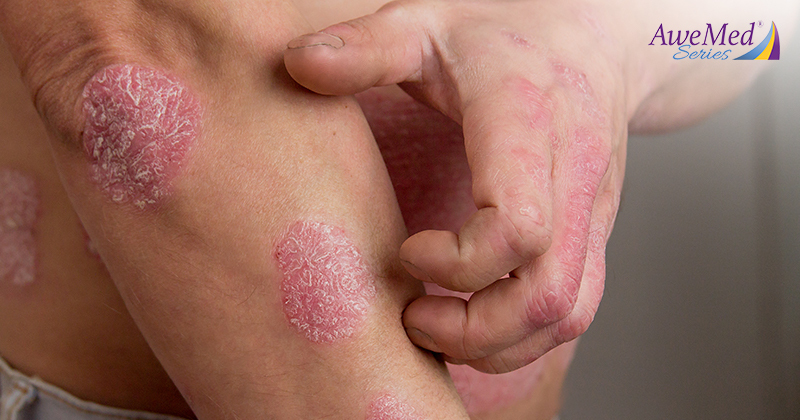
Watching your child battle with the discomfort and frustration of childhood eczema can be heartbreaking. However, with the right approach, you can significantly alleviate their symptoms and manage flare-ups effectively.
In this comprehensive guide, we’ll walk you through everything you need to know about childhood eczema, from its causes and triggers to implementing a structured care regimen. We aim to arm you with the knowledge needed to help your child thrive despite this challenging condition.
Understanding Childhood Eczema
What Is Childhood Eczema?
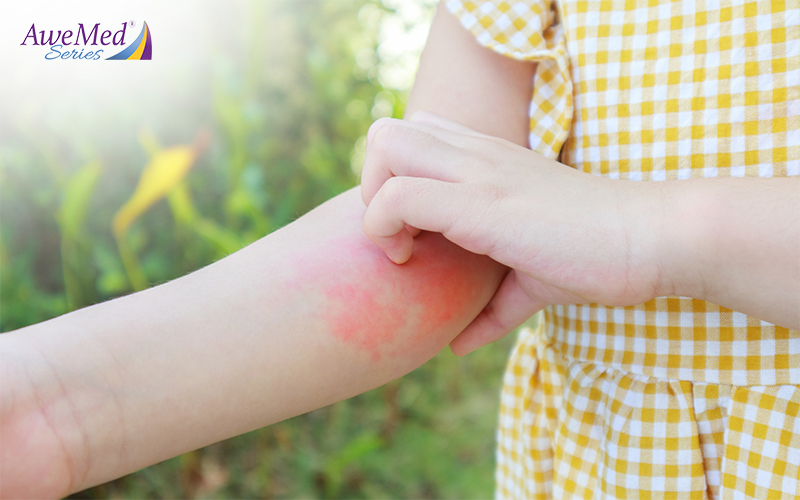
Childhood eczema is a common and chronic skin condition that affects approximately 10% of school-age children in Singapore. It is characterised as patches of inflamed, itchy, and irritated skin on areas like the arms, back of the knees, hands, feet, and face. The security of eczema also varies greatly, ranging from mild, occasional flare-ups to more persistent and severe cases.
While the condition typically appears in your child’s first year of life and can improve with age, some children may experience flare-ups throughout their lives. But beyond the immediate discomfort of redness and itchiness, eczema can significantly impact your child’s emotional well-being. The constant scratching and irritation can affect their sleep, confidence, and ability to participate in activities they enjoy.
However, the good news is that eczema is a manageable condition. With proper and consistent care, it is possible to relieve and mitigate symptoms, prevent lasting skin damage, and improve your little one’s overall quality of life.
Causes and Potential Triggers of Childhood Eczema
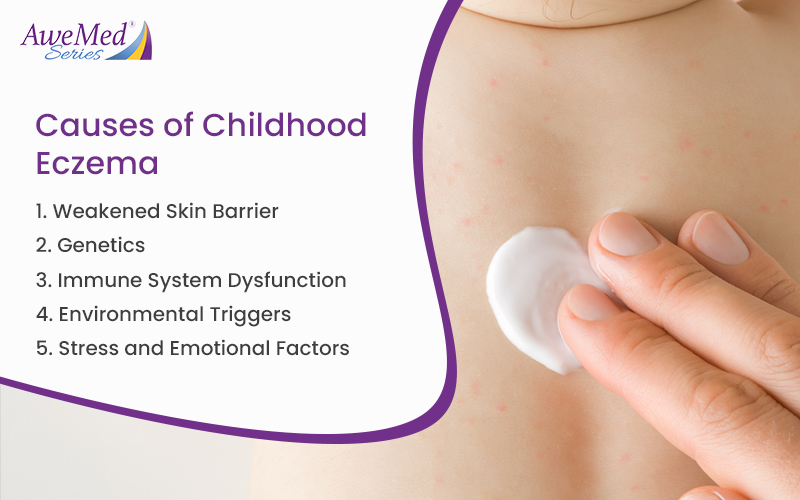
To prevent flare-ups and manage paediatric eczema effectively, understanding the causes and potential triggers is key. Childhood eczema can be caused by various factors, such as genetics, allergens and irritants, environmental factors, and more.
1. Weakened skin barrier
Children with eczema often have a compromised skin barrier, which means their skin struggles to retain moisture and protect against irritants effectively. This weakened barrier leads to dryness, flakiness, and increased vulnerability to inflammation and itching. Additionally, its ability to provide adequate protection from common environmental triggers will be compromised.
2. Genetics
Research shows that genetics can play a significant role in influencing childhood eczema development. Children with a family history of eczema, asthma, or allergies often inherit genetic variations that impact their skin’s barrier function and immune responses, making them more susceptible to outbreaks.
3. Immune system dysfunction
Childhood eczema can also be caused by immune system dysfunction, where the body’s immune response becomes overactive and reacts excessively to allergens and irritants. This results in heightened inflammation and skin irritation, perpetuating a cycle of persistent symptoms in children.
4. Environmental triggers
Various environmental factors can aggravate eczema. Some examples include:
- Allergens: Dust mites, pet dander, pollen, and mould.
- Irritants: Harsh soaps, detergents, certain fabrics (like wool), and even cigarette smoke.
- Weather conditions: Dry or cold weather can lead to dry skin, while humid environments promote fungal growth, triggering flare-ups.
5. Stress and emotional factors
Stress is known to weaken the immune system and provoke inflammatory responses. When your child experiences heightened stress levels, whether due to academic pressures, social challenges, or family dynamics, their bodies may release stress hormones that disrupt immune function and worsen symptoms.
Identifying these triggers early on will enable you to implement targeted strategies to minimise discomfort and improve skin health for your little one.
Learn more: Condition Deep Dive: Eczema Triggers to Avoid
Common Forms of Childhood Eczema
Childhood eczema can manifest in different forms, with each type presenting distinct symptoms and causes that require tailored management strategies.
1. Atopic dermatitis
The most common form of eczema in children, atopic dermatitis is characterised by symptoms such as persistent itchiness, rash, dry skin, occasional flare-ups, scaly or cracked patches, and thickened skin.
2. Contact dermatitis
Contact dermatitis occurs when the skin comes into direct contact with substances that irritate or provoke an allergic reaction. Symptoms include redness, burning sensations, stinging, and, in some cases, blistering or peeling of the skin, typically affecting the exposed areas.
3. Seborrhoeic dermatitis
This form of eczema affects areas of the body with a high concentration of sebaceous glands, including the scalp, face, chest, and back. In infants, seborrhoeic dermatitis is also commonly known as “cradle cap,” causing redness, itching, and the formation of yellow or white, greasy scales on the skin’s surface. While it usually resolves on its own, treatment may be necessary to alleviate discomfort and reduce scales.
4. Dyshidrotic eczema
Dyshidrotic eczema, also referred to as pompholyx eczema or dyshidrosis, primarily affects the hands and feet. Small, intensely itchy blisters may develop on the palms, sides of the fingers, and the soles of the feet, resulting in redness, scaling, and dry, cracked skin, causing significant discomfort.
Although it is more commonly seen in adults, dyshidrotic eczema can also occur in children, where proper management will be required to ease symptoms and avoid future outbreaks.
How to Manage Your Child’s Eczema Condition
For many children with mild to moderate symptoms, eczema persists well into adulthood, often causing recurrent flare-ups that can extend into their 20s. This long journey can be frustrating, with the constant itch and irritation taking a toll on their happiness and self-confidence.
But with long-term and proactive management that starts from a young age, you can equip your child with the tools they need to navigate flare-ups, improve their comfort, and potentially lessen the impact of eczema throughout their life. Let’s explore practical strategies to empower your child on this journey.
Creating a Skin-Safe Environment for Your Child
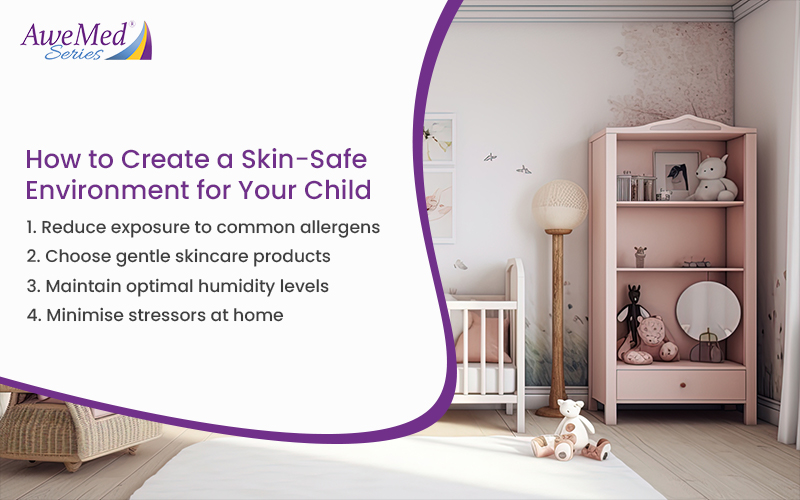
1. Reduce exposure to common allergens
Reducing exposure to common allergens such as pollen, dust mites, pet dander, and mould spores is essential for managing childhood eczema, as these triggers can exacerbate symptoms and lead to flare-ups. Some steps you can take include:
- Regular cleaning and vacuuming of your home
- Using dust-mite-proof covers on mattresses and pillows
- Keeping pets out of your child’s room and off their beds
- Washing your child’s bedding, clothing, and stuffed toys in hot water
- Investing in high-efficiency particulate air (HEPA) filters to trap airborne allergens
This makes your child’s environment less likely to trigger outbreaks, while also providing them with a living space that is conducive to their skin condition.
2. Choose gentle skincare products
Choosing the right skincare products can do wonders for your child’s eczema-prone skin. Opt for hypoallergenic products free from harsh chemicals, fragrances, and dyes that irritate sensitive skin. Instead, choose mild, fragrance-free cleansers that maintain the skin’s natural PH balance, as well as moisturisers specifically formulated for eczema relief. These products contain ingredients that soothe inflammation, reduce itching, strengthen the skin barrier, and replenish moisture without causing further irritation. Additionally, you should always test any new product on a small patch of skin before full application to ensure it does not cause any adverse reactions.
3. Maintain optimal humidity
Maintain optimal humidity levels in your home to keep your child’s skin hydrated and less prone to dryness. Since eczema-prone skin tends to lose moisture easily, higher humidity levels serve to soothe irritation and reduce flare-ups. Use humidifiers in air-conditioned or heated rooms and keep indoor humidity levels between 45 and 55%, as this range provides a comfortable environment that supports healthy skin.
4. Minimise stressors
Minimising stress—a potential trigger for eczema—is crucial. It’s important to create a calm and supportive environment in your home by establishing a consistent daily routine, encouraging relaxation techniques, and providing emotional support for your child.
Developing an Eczema Care Routine
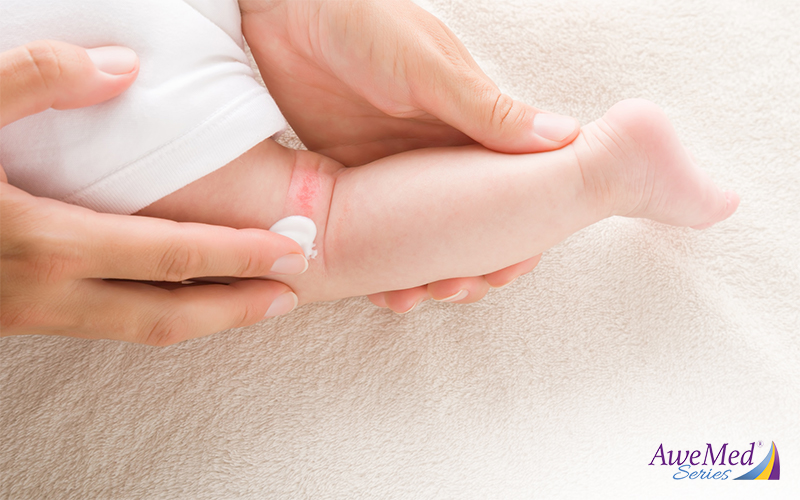
Aside from fostering a skin-safe home environment, you should also assist your child in establishing a consistent eczema care routine.
1. Regular moisturisation
Applying eczema creams and lotions not only hydrates the skin and prevents dryness but also creates a protective barrier against environmental irritants. Help or remind your child to apply these creams multiple times throughout the day, especially right after a bath, where the skin is the most absorbent.
2. Gentle cleansing
Avoid harsh soaps and opt for a mild, fragrance-free body wash for sensitive skin instead. Lukewarm water should also be used during baths, as it can maintain the skin’s natural oils without stripping away moisture, which is crucial for eczema-prone skin. After bathing, pat the skin dry gently with a soft towel rather than rubbing vigorously, as friction can aggravate sensitive skin and exacerbate itching and redness.
3. Appropriate clothing
Reduce irritation by choosing soft, breathable fabrics like cotton and bamboo, and avoid rough materials that are known to irritate sensitive skin, such as wool. Take note to also use gentle laundry detergents free from fragrances and dyes to prevent further skin irritation.
4. Identifying triggers
It is important to identify and avoid substances that worsen eczema symptoms. Potential triggers may include certain foods, environmental allergens, or stress, and this can vary among individuals. Keeping a diary to track flare-ups and possible triggers can pinpoint patterns, allowing you to make informed lifestyle adjustments, such as dietary modifications or environmental adjustments.
Taking a proactive approach to your child’s eczema reduces the frequency and severity of their outbreaks, bringing them greater comfort and improving their quality of life in the long run.
Nutrition and Diet for Eczema
Despite being primarily a skin condition, nutrition and diet play a pivotal role in managing eczema outbreaks. Certain foods can trigger flare-ups, while others can help reduce inflammation and support overall skin health, making dietary choices an important aspect of eczema care.
1. Avoid common food allergens
While specific eczema triggers vary by the individual, the common types of food to avoid include cow’s milk, eggs, soy, wheat, and peanuts, as these are known to exacerbate symptoms in susceptible children. Carefully observe and identify these triggers, possibly through allergy testing if needed, and eliminate them from your child’s diet.
2. Adopt a balanced diet
At the same time, adopting a balanced diet rich in essential nutrients can promote healthier skin and alleviate eczema flare-ups. Foods high in omega-3 fatty acids like fish, flaxseeds, and walnuts possess anti-inflammatory properties, while probiotics in yoghurt and fermented foods can support your child’s immune system.
3. Incorporate foods rich in antioxidants
Antioxidants also play a key role in combating oxidative stress and inflammation associated with eczema. Consider adding foods like berries, spinach, kale, and nuts into your child’s diet, as they are rich in antioxidants such as vitamins C and E. These can help to alleviate eczema symptoms and promote healthier skin.
4. Consult a professional
However, for tailored, one-to-one guidance, it is best to consult with a healthcare provider or a nutritionist. These professionals will craft a diet plan that meets your child’s unique dietary needs while avoiding triggers and allergens. This personalised approach ensures that any dietary adjustments are made in a safe and informed manner, taking into account any other health conditions, nutritional requirements, and potential food sensitivities.
Frequently Asked Questions About Childhood Eczema
1. Can moisturisers help with eczema?
Yes, moisturisers are essential for eczema care as they help to hydrate the skin, reduce dryness, and strengthen the skin barrier. However, not all moisturisers work the same way. You’ll need to choose those specially formulated for eczema-prone skin and can provide better protection and relief from symptoms.
2. How often should I apply moisturiser for eczema?
Apply moisturisers at least twice a day, especially after bathing, to keep the skin hydrated.
3. Is it safe to use moisturisers on infants with eczema?
Yes, moisturisers designed for infants with eczema can be safely used to keep their skin hydrated and comfortable.
4. Can eczema be treated?
Eczema cannot be permanently cured, but it can be effectively treated and managed to reduce symptoms and improve quality of life. Treatment involves regular moisturization to maintain skin barrier function, using anti-inflammatory eczema itch relief creams and sprays, and identifying triggers.
5. How can I prevent eczema flare-ups in my child?
Maintain a consistent skincare routine, avoid known triggers, and consult a paediatrician or dermatologist for personalised advice and treatment options.
6. Should I see a doctor for my eczema condition?
If your condition persists and is affecting you, it’s important to consult a medical specialist. Your dermatologist will assess the severity of your condition and provide individualised treatment plans.
Conclusion
Caring for a child with eczema requires patience, understanding, and a well-rounded approach to managing symptoms and triggers. By implementing the strategies outlined in this guide, you can provide the care and comfort they need to lead happy and healthy lives.
Consider exploring AweMed Series’ specialised eczema-care products to further support your child’s skin care needs. Our collection includes gentle eczema creams, soothing moisturisers, and more to manage and alleviate symptoms.
Give your child the comfort they deserve with our products today.
References
Alexandria. (2021, July 13). Childhood Eczema Often Persists Into Adulthood. National Eczema Association. https://nationaleczema.org/blog/childhood-eczema-persists-adulthood/
Biagini Myers, J. M., & Khurana Hershey, G. K. (2010). Eczema in early life: genetics, the skin barrier, and lessons learned from birth cohort studies. The Journal of pediatrics, 157(5), 704–714. https://doi.org/10.1016/j.jpeds.2010.07.009
Dyshidrotic eczema: symptoms, causes, and treatment. (2022, October 31). National Eczema Association. https://nationaleczema.org/eczema/types-of-eczema/dyshidrotic-eczema/
Schwartz, B. (2023b, April 17). Foods That Reduce Eczema Flare Ups | Schweiger Dermatology Group. Schweiger Dermatology Group. https://www.schweigerderm.com/skin-care-articles/eczema/foods-that-reduce-eczema-flare-ups/
Wang, X. S. (2004). The prevalence of asthma and allergies in Singapore; data from two ISAAC surveys seven years apart. Archives of Disease in Childhood, 89(5), 423–426. https://doi.org/10.1136/adc.2003.031112


